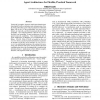Free Online Productivity Tools
i2Speak
i2Symbol
i2OCR
iTex2Img
iWeb2Print
iWeb2Shot
i2Type
iPdf2Split
iPdf2Merge
i2Bopomofo
i2Arabic
i2Style
i2Image
i2PDF
iLatex2Rtf
Sci2ools
AAAI
1997
1997
Agent Architectures for Flexible, Practical Teamwork
Teamwork in complex, dynamic, multi-agent domains mandates highly flexible coordination and communication. Simply fitting individual agents with precomputed coordination plans will not do, for their inflexibility can cause severe failures in teamwork, and their domain-specificity hinders reusability. Our central hypothesis is that the key to such flexibility and reusability is agent architectures with integrated teamwork capabilities. This fundamental shift in agent architectures is illustrated via an implemented candidate: STEAM. While STEAM is founded on the joint intentions theory, practical operationalization has required it to integrate several key novel concepts: (i) team synchronization to establish joint intentions; (ii) constructs for monitoring joint intentions and repair; and (iii) decision-theoretic communication selectivity (to pragmatically extend the joint intentions theory). Applications in three different complex domains, with empirical results, are presented.1
| Added | 01 Nov 2010 |
| Updated | 01 Nov 2010 |
| Type | Conference |
| Year | 1997 |
| Where | AAAI |
| Authors | Milind Tambe |
Comments (0)

